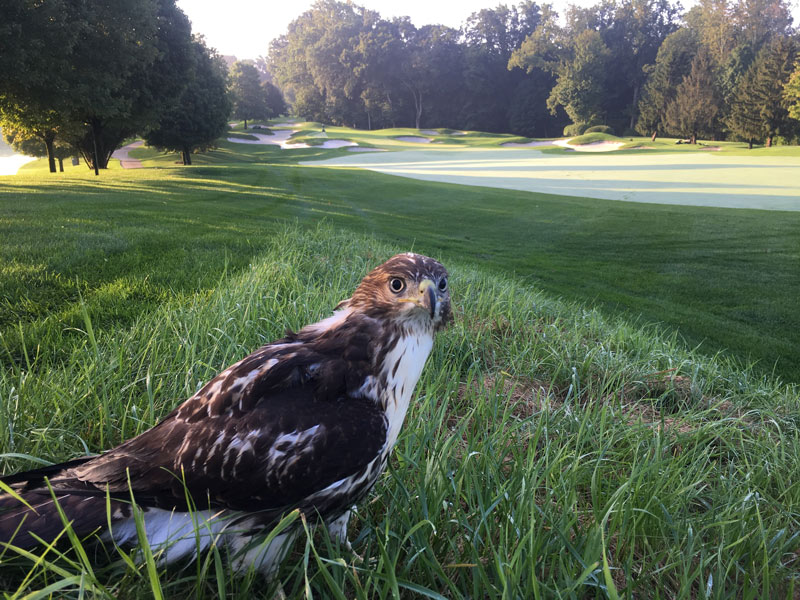
A hawk eyes the surroundings at TPC Jasna Polana in Princeton, N.J., where Tim Connolly, CGCS, keeps a close eye on water quality and consumption. The 18-hole course, designed by Gary Player and opened in 1998, is a Certified Audubon Cooperative Sanctuary. Photos by Tim Connolly
A name like “bright meadow” gives a piece of land certain aesthetic expectations to live up to. And when that property is a private golf course, a lush, picturesque landscape seems an even greater given. At TPC Jasna Polana — “bright meadow,” in Polish — in Princeton, N.J., director of golf course maintenance operations Tim Connolly, CGCS, has embraced the challenge of keeping the 18-hole facility true to its idyllic title while also keeping conscientious water management central to the club’s identity.
“Water is essential to our lives, and if there’s something I can do in my job that’s going to enhance water quality and conservation, I welcome that,” says Connolly, a 15-year GCSAA member, who has been at the agronomic reins at TPC Jasna Polana since 2012. “My belief is the more we chip away at it and can make incremental improvements, the more obvious the benefits will become in terms of annual reduction in our water usage. I also believe every gallon counts.”
Connolly’s commitment was recognized in June, when TPC Jasna Polana received River-Friendly certification from the local Stony Brook-Millstone Watershed Association (SBMWA). The club spent about two years working to achieve the designation. “River-Friendly” encompasses all aspects of land use that concern water, says Steve Tuorto, SBMWA’s director of science and stewardship. For a golf course, it requires meeting rigorous standards for stormwater management, water conservation and integrated pest management, among other criteria. SBMWA partners with two other organizations to administer the River-Friendly certification program for businesses and residences throughout New Jersey. Seven golf courses have earned the distinction.
“Golf courses represent a tremendous opportunity,” Tuorto says. “They have the potential to significantly impact the environment, and they have a great trickle-down effect in terms of spreading a message and raising the water IQ of everyone involved — showing people the little things they can do and how to change their behavior.”

A blend of fine fescue borders No. 18 at TPC Jasna Polana.
TPC Jasna Polana’s journey to River-Friendly certification has been one of gradual, relatively small steps, making its example one most golf courses can follow. A staple of dialing back water use is reducing irrigated acreage, a strategy that Connolly and his team pursued by surveying sprinkler head locations and plotting new, harmonious grassing lines. The result has been a conversion of 10 out-of-play acres of Kentucky bluegrass to a blend of fine fescue that requires no irrigation in the temperate climate. (TPC Jasna Polana sources irrigation from two wells and has a 3-acre, 9-million-gallon irrigation pond.) Three additional acres of formerly maintained rough have been replaced with mixtures of native wildflowers that thrive without supplemental water and also furnish exceptional pollinator habitat.
Another cornerstone of Connolly’s water-minded approach has been testing — annual testing of groundwater and surface water quality, and, for the past three years, trialing of Latitude 36 bermudagrass in the practice facility with different soil types and heights of cut. The drought-tolerant, cold-hardy grass has performed well, and Connolly says he’ll continue to test it through at least another winter before thinking longer-term (the course currently has bentgrass greens, tees and fairways). “The potential water savings could be significant with this kind of grassing change, so it has been worth the time and effort to consider it,” he says. Also on the agenda at TPC Jasna Polana: an audit of the course’s 20-year-old irrigation system. Connolly attended the irrigation auditing seminar at the 2017 Golf Industry Show so he’d be able to tackle the task in-house.
For superintendents just dipping their toe into wiser water practices, Connolly suggests starting with the basics by simply observing your irrigation system in action and documenting wet and dry spots. Assess other factors that can affect water use — aerification, soil fertility, trees — and communicate with management and membership to establish an “aesthetic threshold” for the golf course. “If everyone agrees that the course doesn’t have to be emerald green every day, the superintendent is going to have a much easier time of making a truly impactful difference in water usage,” Connolly says.
Finally, both Connolly and Tuorto recommend tapping the site-specific, science-based expertise of your local watershed association to ensure success with your initiatives. “It allows us to work with people who are within the community and who want to see us succeed as a business,” says Connolly of the relationship TPC Jasna Polana has cultivated with SBMWA. “They touch a lot of people, and through them I’ve also been able to connect with people of like mind who are outside of golf, to see what things they’re doing to improve their environmental status. To have that as a resource for us has been valuable.”
To find your watershed and connect with a local watershed group, go to the EPA’s Surf Your Watershed website.
Megan Hirt is GCM’s managing editor.